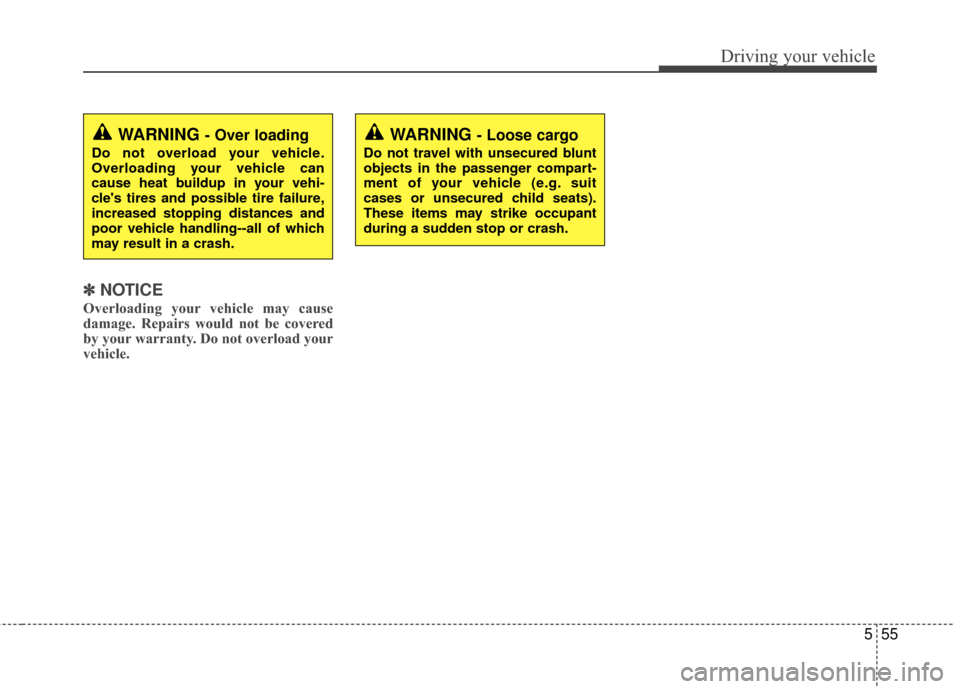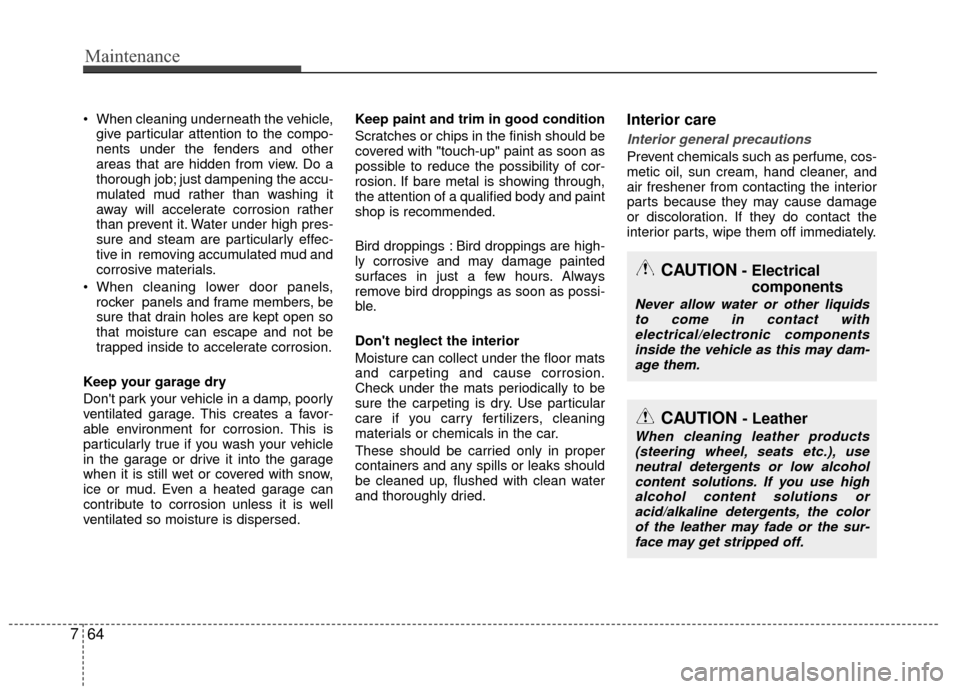2015 KIA Rio seats
[x] Cancel search: seatsPage 280 of 398

555
Driving your vehicle
✽
✽NOTICE
Overloading your vehicle may cause
damage. Repairs would not be covered
by your warranty. Do not overload your
vehicle.
WARNING - Over loading
Do not overload your vehicle.
Overloading your vehicle can
cause heat buildup in your vehi-
cle's tires and possible tire failure,
increased stopping distances and
poor vehicle handling--all of which
may result in a crash.
WARNING - Loose cargo
Do not travel with unsecured blunt
objects in the passenger compart-
ment of your vehicle (e.g. suit
cases or unsecured child seats).
These items may strike occupant
during a sudden stop or crash.
Page 356 of 398

745
Maintenance
Temperature -A, B & C
The temperature grades are A (the
highest), B and C representing the
tire’s resistance to the generation of
heat and its ability to dissipate heat
when tested under controlled condi-
tions on a specified indoor laboratory
test wheel.
Sustained high temperature can
cause the material of the tire to
degenerate and reduce tire life, and
excessive temperature can lead to
sudden tire failure. Grades B and A
represent higher levels of perform-
ance on the laboratory test wheel
than the minimum required by law.Tire terminology and definitions
Air Pressure: The amount of air
inside the tire pressing outward on
the tire. Air pressure is expressed in
kilopascal (kPa) or pounds per
square inch (psi).
Accessory Weight
: This means the
combined weight of optional acces-
sories. Some examples of optional
accessories are, automatic
transaxle, power seats, and air con-
ditioning.
Aspect Ratio : The relationship of a
tire's height to its width.
Belt: A rubber coated layer of cords
that is located between the plies and
the tread. Cords may be made from
steel or other reinforcing materials.
Bead: The tire bead contains steel
wires wrapped by steel cords that
hold the tire onto the rim.
Bias Ply Tire : A pneumatic tire in
which the plies are laid at alternate
angles less than 90 degrees to the
centerline of the tread. Cold Tire Pressure: The amount of
air pressure in a tire, measured in
kilopascals (kPa) or pounds per
square inch (psi) before a tire has
built up heat from driving.
Curb Weight: This means the weight
of a motor vehicle with standard and
optional equipment including the
maximum capacity of fuel, oil and
coolant, but without passengers and
cargo.
DOT Markings: The DOT code
includes the Tire Identification
Number (TIN), an alphanumeric des-
ignator which can also identify the
tire manufacturer, production plant,
brand and date of production.
GVWR: Gross Vehicle Weight Rating
GAWR FRT: Gross Axle Weight
Rating for the Front Axle.
GAWR RR: Gross Axle Weight
Rating for the Rear axle.
Page 375 of 398

Maintenance
64
7
When cleaning underneath the vehicle,
give particular attention to the compo-
nents under the fenders and other
areas that are hidden from view. Do a
thorough job; just dampening the accu-
mulated mud rather than washing it
away will accelerate corrosion rather
than prevent it. Water under high pres-
sure and steam are particularly effec-
tive in removing accumulated mud and
corrosive materials.
rocker panels and frame members, be
sure that drain holes are kept open so
that moisture can escape and not be
trapped inside to accelerate corrosion.
Keep your garage dry
Don't park your vehicle in a damp, poorly
ventilated garage. This creates a favor-
able environment for corrosion. This is
particularly true if you wash your vehicle
in the garage or drive it into the garage
when it is still wet or covered with snow,
ice or mud. Even a heated garage can
contribute to corrosion unless it is well
ventilated so moisture is dispersed. Keep paint and trim in good condition
Scratches or chips in the finish should be
covered with "touch-up" paint as soon as
possible to reduce the possibility of cor-
rosion. If bare metal is showing through,
the attention of a qualified body and paint
shop is recommended.
Bird droppings : Bird droppings are high-
ly corrosive and may damage painted
surfaces in just a few hours. Always
remove bird droppings as soon as possi-
ble.
Don't neglect the interior
Moisture can collect under the floor mats
and carpeting and cause corrosion.
Check under the mats periodically to be
sure the carpeting is dry. Use particular
care if you carry fertilizers, cleaning
materials or chemicals in the car.
These should be carried only in proper
containers and any spills or leaks should
be cleaned up, flushed with clean water
and thoroughly dried.Interior care
Interior general precautions
Prevent chemicals such as perfume, cos-
metic oil, sun cream, hand cleaner, and
air freshener from contacting the interior
parts because they may cause damage
or discoloration. If they do contact the
interior parts, wipe them off immediately.
CAUTION- Electrical
components
Never allow water or other liquids
to come in contact withelectrical/electronic componentsinside the vehicle as this may dam- age them.
CAUTION - Leather
When cleaning leather products(steering wheel, seats etc.), useneutral detergents or low alcoholcontent solutions. If you use highalcohol content solutions oracid/alkaline detergents, the color of the leather may fade or the sur-face may get stripped off.
Page 396 of 398

Index
8I
Scheduled maintenance service ··················\
··················\
···7-7Maintenance under severe usage conditions ···············7-20
Normal maintenance schedule··················\
··················\
···7-8
Seat belt warning ··················\
··················\
··················\
·····3-13
Seat belts ··················\
··················\
··················\
··················\
3-12 3 Point rear center belt ··················\
··················\
············3-16
Hight adjustment ··················\
··················\
··················\
···3-15
Pre-tensioner seat belt ··················\
··················\
·············3-17
Seat belt - Driver's 3-point system ··················\
············3-14
Seat belt warning ··················\
··················\
··················\
···3-13
Seat belts - Front passenger and rear seat ··················\
·3-16
Seat Warmer ··················\
··················\
··················\
···············3-7
Seatback pocket ··················\
··················\
··················\
·········3-8
Seating capacity ··················\
··················\
··················\
·······5-52
Seats ··················\
··················\
··················\
··················\
·········3-2 Folding the rear seat ··················\
··················\
················3-10
Front seat adjustment·············\
··················\
··················\
····3-4
Headrest(front) ··················\
··················\
··················\
········3-5
Headrest(rear) ··················\
··················\
··················\
··········3-9
Rear seat ··················\
··················\
··················\
··················\
3-9
Seatback pocket ··················\
··················\
··················\
·······3-8
Warmer ··················\
··················\
··················\
··················\
··3-7
Shift Lock ··················\
··················\
··················\
················5-19
Shopping bag holder ··················\
··················\
··················\
4-99
Side impact air bag ··················\
··················\
··················\
··3-44
Smart key ··················\
··················\
··················\
··················\
·4-4 Smooth cornering··················\
··················\
··················\
·····5-45
Snow tires ··················\
··················\
··················\
················5-48
Spare tire
Compact spare tire ··················\
··················\
··················\
·6-19
Compact spare tire replacement ··················\
················7-41
Removing and storing the spare tire···········\
·················6-14\
Special driving conditions ··················\
··················\
·········5-44 Driving at night ··················\
··················\
··················\
·····5-45
Driving in flooded areas ··················\
··················\
··········5-46
Driving in the rain ··················\
··················\
··················\
·5-46
Hazardous driving conditions ··················\
··················\
··5-44
Highway driving ··················\
··················\
··················\
····5-47
Rocking the vehicle ··················\
··················\
·················5-44\
Smooth cornering ··················\
··················\
··················\
··5-45
Speedometer··················\
··················\
··················\
·············4-42
Sports mode ··················\
··················\
··················\
·············5-17
SRS components and functions ··················\
··················\
·3-33
Starting difficulties, see engine will not start ··················\
6-3
Steering wheel ··················\
··················\
··················\
·········4-35 Electric power steering ··················\
··················\
············4-35
Horn ··················\
··················\
··················\
··················\
·····4-37
Tilt & Telescoping steering ··················\
··················\
·····4-36
Steering wheel audio control ··················\
··················\
···4-103
Steps For Determining Correct Load Limit ··················\
5-52
Storage compartment ··················\
··················\
·················4-92\
Center console storage·············\
··················\
··················\
4-92
Cool box ··················\
··················\
··················\
················4-93
Glove box ··················\
··················\
··················\
··············4-92
S